Horror
Why You Should Watch The Tunnel

A week and a bit ago, The Tunnel, an indie Australian horror film was released for free online. The creators have taken a daring approach to film distribution, attempting to cover the $135,000 production cost of their film by selling individual frames on their website, releasing a deluxe DVD and organising a couple screenings. A lot has been said already about this side of the project so… let’s ignore it all together and focus on the actual film.
The Tunnel is a pretty damn decent ‘found-footage’ style movie. As such, comparisons to other similarly styled/gimmicky (delete-as-per-your-taste) are absolutely inevitable. Amongst such competition, by my reckoning, The Tunnel mounts a pretty strong defence and, whilst it’s by no means the best around, it certainly holds its own. And kicks Paranormal Activity all over the park (although, in truth, that isn’t exactly hard…)
The unique selling point in this case is the presentation of the story as a documentary, with talking-heads style interviews with several of the lead characters involved in the story. This, as should be immediately obvious, has a fairly massive downside… You. Know. Who. Survives. I’m not giving anything away here at all (I do seriously hope lots of people will watch this) but, given that we expect people to die in horror films (that’s what happens!), the fact that the film makers show us two of the four lead characters talking to the camera from the start leaves the audience to draw some fairly easy conclusions!
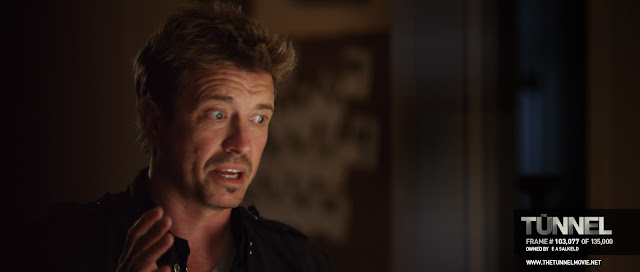

Minor documentary-gripe aside, they do succeed in setting up a genuinely intriguing story. With contemporary fears over water-shortages, the New South Wales government have come up with a new plan to use the miles of abandoned train tunnels that run underneath the city for water storage. For various reasons, this leads to our starring group of intrepid (and possibly implausibly stupid…) band of journalists to go exploring in the dark. Sadly, they’ve told no-one they were going (they clearly haven’t seen 127 Hours). And they’re staggeringly under-prepared and under-equipped. Even Theseus took a thread with him when he went into the labyrinth!
Needless to say, all sorts of tragedy, violence and scary noises ensues.
Again, I don’t want to go into too much detail about what actually occurs. The camera wiggles, night-vision comes and goes, screams and cries echo through the tunnels. It’s stylishly and competently put together and puts their sub-Sydney environment to good use. The only criticism I can really level at the film, however, is that with such an interesting background story created for the film, much of the detail and interest gets forgotten about from around halfway through. They’re not the only ones who do it - District 9 forgets entirely about its mockumentary format from about 30 minutes in - but it did leave me wanting a little bit more from the story. I’m not the kind of viewer who likes to be spoon-fed an easy solution, but having interested me in the story, to forget about it was a bit of a let down. Perhaps, like the creators of [REC], they intend to reveal a lot more of the story, the causes, etc. in a future instalment. Perhaps they don’t.
Either way, The Tunnel is a well-made, decently paced and enjoyable film. It’s interesting, genuinely creepy in places and leaves you wanting more (or though not in an entirely positive way). Oh, and did anyone mention that it’s free?
Who cares what I think? Head over to VODO and grab your free copy
or go and buy the DVD.
European Post-2000 Horror
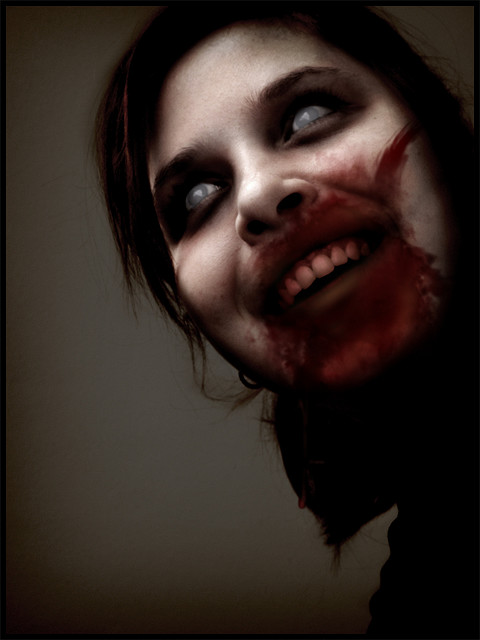
Rather splendid zombie, by ‘scabeater’, under a CC-by-nc-nd licence
So… after the brief but exciting burn-out that was the intensive Argento-fest in March, it’s time to move to a bit of a new project. This one, rather than the as-much-as-possible-in-a-week format, will be somewhat more drawn out, allowing me to do other stuff in between. Like eating. And sleeping.
The project plan is to watch more Horror. Specifically, Horror from Europe (this is not a slight on the rest of the world, honest! I’d just like to see more Euro-Horror). Even more specifically, European Horror from the last ‘decade’. I’m taking decade to mean Y2K onwards, so perhaps should better say the project’s full name ought to be: 21st Century European Horror.
Now I’ve seen a few of these already - I expect you have too. I’m not going to be strict about only watching new things, about the boundaries of Europe or… well, about anything really. This is supposed to be fun, after all.
There’s a nice list by someone called ‘propelas’ here of some of the highlights of C21EH (as it shall now be known). ‘ratty1984’ also contributes a short list over at IMDB. Although I love lists (I really do…), my intention here is not to make a list, I have no plans to be comprehensive about this, I just want to watch some horror.
And with films like Martyrs, El Orfanato, [Rec] (and [Rec]2) and Sauna (AKA Filth) on the list, it should be good fun. c21EH, here we come…
Edit: And new project means new banner, hurrah!

Suspiria
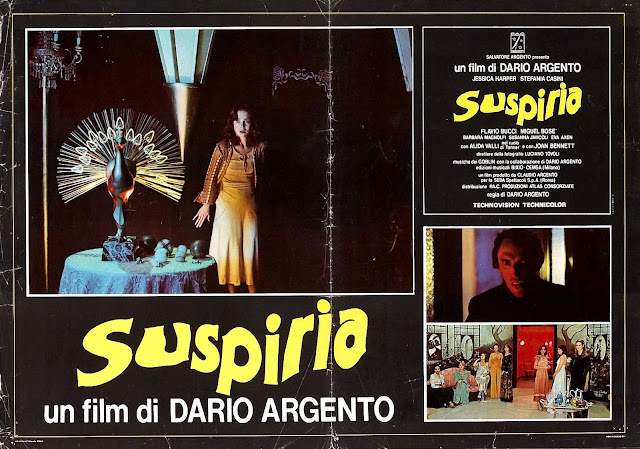
SUSSSSSSSSPIRIA! On a great big screen!
Last night, after a week of Argento film’s, I got to see his spellbinding masterpiece Suspiria on a cinema-screen in the National Media Museum as part of the Bradford International Film Festival. I’d obviously wound myself into a bit of a frenzied excitement about it through the week and it certainly did not disappoint.
Every time I hear someone say they choose to watch films at home rather than at the cinema, mostly due to all the other film-goers, I think to myself “You’ve just been going to the wrong films with the wrong people!”. Last night’s audience had almost all seen the film before and sat in captivated silence, tittering nervously at the occasional gentle comic moments and - even before fun - audibly anticipating oncoming moments of horror. If a bad crowd can ruin a film, a great crowd can make one. Not that Suspiria needed any help in that respect…
My first and only minor gripe is that it was very sadly the cut version. This was an original cinematic print taken from the Media Museum’s extensive archive and so was a print of the X-rated version that the BBFC approved in 1977, after demanding 1m13 of cuts (Cut info at Melon Farmers). Now, to those not familiar with horror film, particularly of BBFC-butchered horror film of a couple of decades ago, 1m13 might not sound very much. It also might not sound so important if I tell you that the full extent of the cuts involved removing a series of close-ups of stabbing, someone struggling through barbed wire and a dog biting a man’s throat. Cuts, however, do make a difference to the rhythm and pacing of a film. Suspira is a film that, like so many Argento, thrives on the atmospheric build-up, to the point that the death scenes actually become a kind of release. For a couple of them to be dramatically shortened here was a shame.
Still, whilst that was the downside to it being an original theatrical print, there were certainly upsides. The first (and some would reject this) was that the image did have a wonderfully scratchy look. Anyone who’s seen a film in cinemas that was filmed entirely in HD-digital knows how clinical and sterile it can look (I’m looking at you Public Enemy!) and, whilst I’m not suggesting scratchy is the way forward, there was certainly something enjoyable about watching a 70s film I thought I’d never see in a cinema, complete with all the visual wear and tear that a 30 year old 35mm reel has experienced (even if carefully looked after by the Museum)
The second benefit was the sound. The sound! Anyone who’s seen Suspiria, an Argento film or evne read any of my blog from this week will know that sound makes up an enormous part of Argento’s films. Suspiria is (arguably) the very best of these, scored again by the ever wonderful Goblin, and positively throbs, jangles and crashes at you. Original print, combined with cinema sound system made it an utterly fantastic experience that I’m sure I’ll never be able to repeat (especially as most commercial releases saw the soundtrack savagely remixed).
The film itself is a whirling, semi-nonsensical, breathtaking journey of colour and sound, moving from the giallo murder-mystery into something a whole lot more supernatural, with savagely brilliant results. I really don’t want to say too much more about the actual film, save to say that it is pretty much the best example of all the techniques I’ve been seeing this week in all his other films. It’s not perfect (the scene-with-the-bat is awful) but it’s brilliant, beautiful and should be seen by everyone.
Phenomena
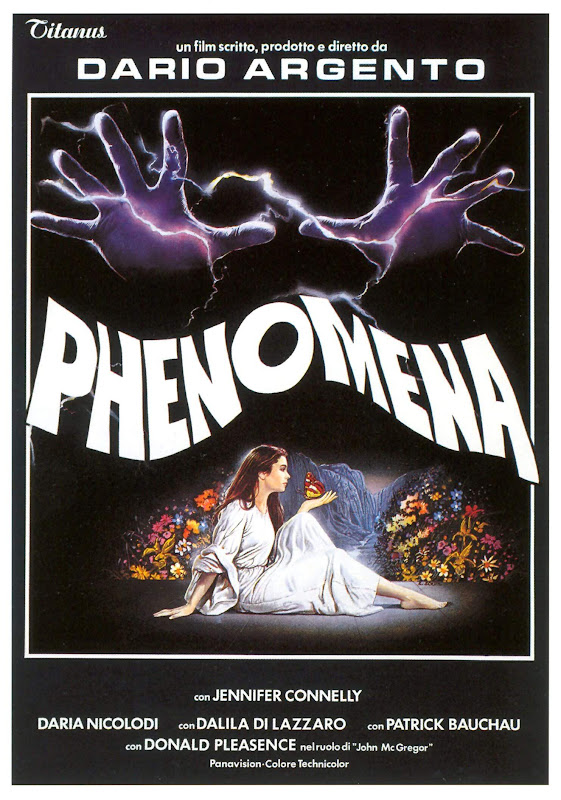
Another new (to me) Argento film, another next-day post. The problem this time, though, is that I still don’t know what to think. Phenomena has me confused; it could either be my least favourite Argento film yet or it could even be - whisper it- my favourite. I certainly will need to see it again beofre I’m sure.
It has all the faults you could accuse an Argento film of, and it has them by the bucketfull. The story is pretty much nonsensical. The dialogue is clumsy. The acting is as wooden as it gets. If I wanted (and several IMDB reviewers have wanted to) I could make this sound like a truly awful film. It’s about a half-mad girl who communicates with insects, for heaven’s sake!
So… it’s a bad film right?
Wrong.
Phenomena is, as with so many of these films, not really meant to be a narrative to follow, a dramatic performance to astound or a literary tour-de-force. It’s an experience. It’s a film you have to sit and give your full attention to. So surrender your art-critic pretensions and just immerse yourself in it. There’s a lot to like!
She does, after all, communciate with insects! This, predictably, does not mean talking to ladybirds but rather invokes biblical-plagues of flying terrors, ready to sting, nibble and smother anything in their way.
It also has Donald Pleasence (always a good thing) and a monkey.
And…
Welll…..
If I seem to be struggling to find useful things to say about this film it’s really only because it has such an absolutely brilliant, arresting, throat-grabbing, mind-boggling wonder of an ending. The film was good, sure, but the last quarter of an hour or so utterly trumped it. It’s not frightening as such (there’s certainly no scene to equal the dog-chases-girl in Tenebrae) but it is tense, it is shocking and it is delivered with enthusiasm and panache!
It would be such a shame to spoil it for anyone who hasn’t seen it, so I’ll carefully guard my tonguer (er… keys?) and leave you with a very unsatisfactorary conclusion. Phenomena is quite possibly utter rubbish with a chilling ending. Or it is quite possibly a stunning film that needs to be experienced. I’m just not sure.
Either way, I certainly need and want to watch it again.
Opera
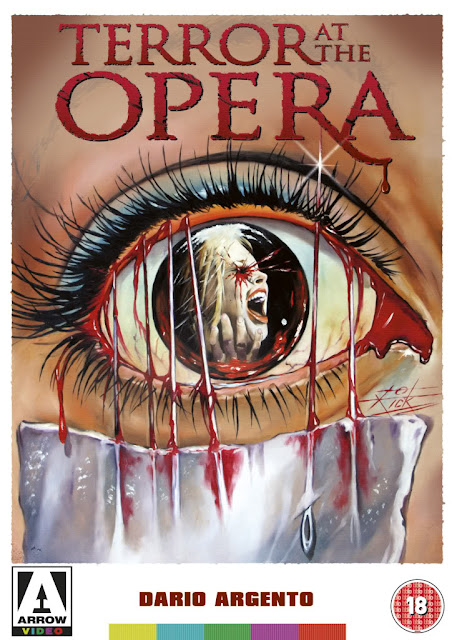
So, part one of Chopping Mall’s Dario Argento Week is his 1987 masterpiece Opera.
This is pitched, as a few of his films are, somewhere between straight up giallo whodunit and a tense psychological horror. With gruesome death scenes. So, you could say, it manages to do a bit of everything that’s awesome about Italian cinema. Except Westerns. There are certainly no cowboys…
The basic premise sees Betty called in at the last minute to perform in the opera of MacBeth. The famous curse of the Scottish play has struck down the intended Lady MacBeth, leaving the role wide open for the young and inexperienced Betty. She steps up to the mark - and gets rave reviews - but from this moment on things really start to go wrong: lights crash to the floor on the opening night, staff members are found dead and then Betty encounters a mysterious masked man…
This guy, it turns out, has quite a sadistic edge to him and happily tied her up, tapes needles to the bottom of her eyes - so she can’t close her eyes in horror, of course - and then precedes to stab her lover in front of her. Through the throat.
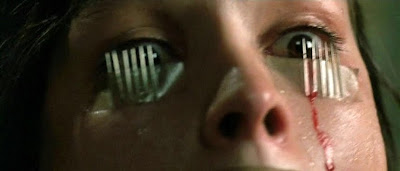
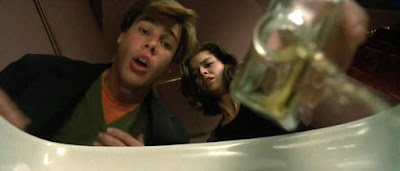
I shan’t elaborate too much on the rest of the plot, as that would spoil the surprise, although perhaps that wouldn’t matter too much. To my mind, the weakest element of Opera is that I really don’t care that much who’s responsible for the murders and - I suspect - Argento doesn’t either. The combination of surprisingly few clues or half-remembered vital details (especially in comparison to some of his other films…) and the sheer indulgence of the murders (lookout for the one with the keyhole…) suggest that this is a film that’s concerned less with who’s doing the crime than er… simply enjoying watching the crime.
Its real strong point however is the astonishingly brilliant camera work. I suspect I’m going to have to spend most of this week hunting out alternative superlatives for the cinematography in Argento’s films, but for now I must say that the visual element of Opera is simply stunning. It’s hard to do it justice in screenshots, simply because this is less about camera angles than about camera movement; Argento’s camera leads us through the film, ducking behind curtains, drawing back ominously, following the heels of characters as they walk. This is the real magic of the film; we never simply watch the action but rather are immersed in it. Argento throws the viewer into the scene, compelling us to watch the grisly details as surely as if it were our eyes that were forced open by needles.
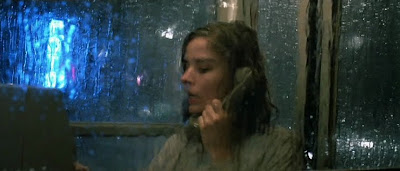
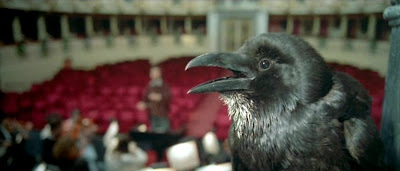
Opera is certainly not everyone’s film, it’s certainly not simply a murder mystery and it’s certainly not the best constructed story you’ll watch/read/encounter. What it is, however, is utterly compelling viewing, visually astonishing and an awful lot of fun.
The only remaining points to note are the brilliance of the crows - surely the most threatening birds in cinema after those of The Birds - and, less brilliantly, the appalling choices made in the soundtrack. With brilliant excerpts of opera music, it seems such a shame to throw in the odd chunk of metal-ish guitar rock, which in most cases simply kills the atmosphere. It’s a far cry, say, from the dipping-with-tension(-and-blood) soundtrack to Suspiria….